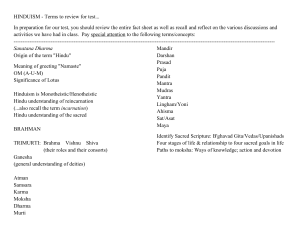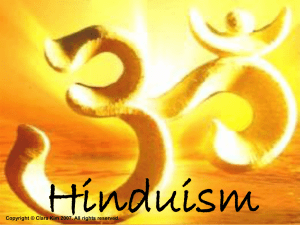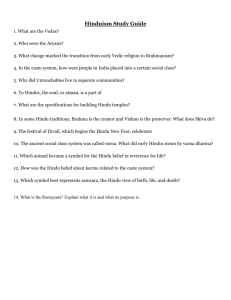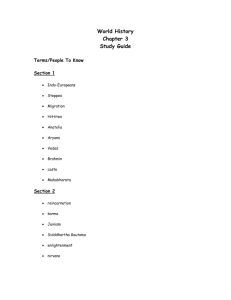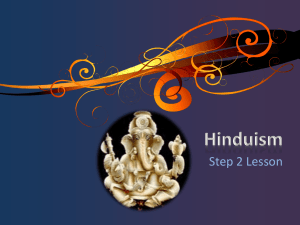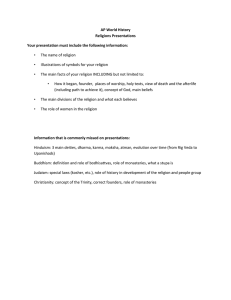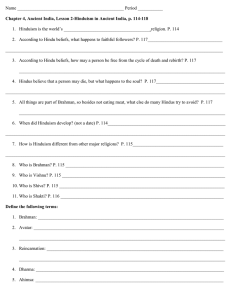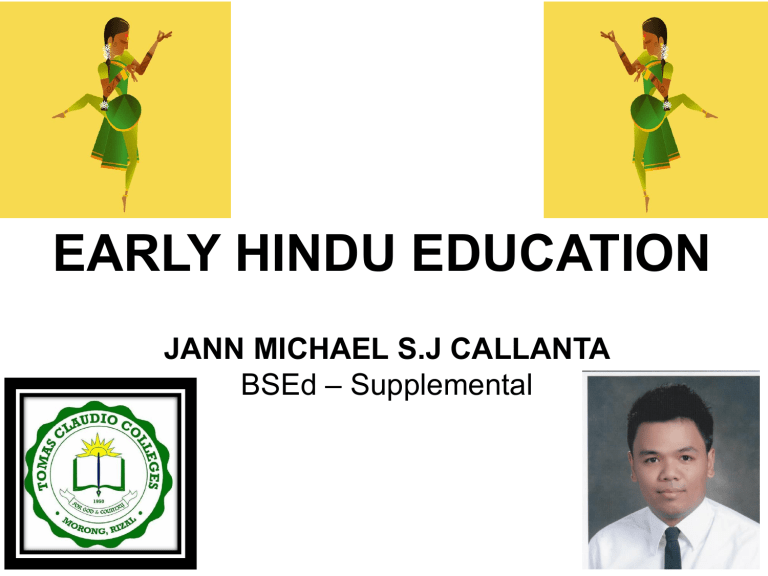
EARLY HINDU EDUCATION JANN MICHAEL S.J CALLANTA BSEd – Supplemental Father God Almighty, Thank you so much for this day. Thank you for the strength, for the life and for all you blessings. Forgive us of our sins and cleanse us all. We commit this day for your glory and honor. Make this day a fruitful and successful. In Jesus Name we pray. AMEN. Enabling Objectives: •To know more about Early Hindu Education and their outstanding contribution to the education. •To identify the Aims of Early Hindu Education. •To differentiate the Method of Instruction of Early Hindu Education. INTRODUCTION • • • • • The civilization of Early Hindu are among the earliest civilization of the world. What are civilization? Civilization: n. –the stage of human social and cultural development and organization that is considered most advanced n. –the society, culture and way of life of a particular area In this topic, Early Hindu Education will be our main focus to be studied. ACTIVITY: BE HOOKED! WORD SEARCH Directions: Search for the words provided in the word search puzzle. Dharma Artha Kama Moksha ACTIVITY: BE HOOKED! WORD SEARCH Directions: Search for the words provided in the word search puzzle. Dharma Artha Kama Moksha ACTIVITY: BE HOOKED! Directions: Tell the name of the place that is shown in the picture. ANALYSIS What is the importance of education for Hindus? • In Hinduism education is an important means to achieve the four aims of human life, namely dharma (virtue), artha (wealth), kama (pleasure) and moksha (liberation). • Knowledge is a double edged sword. With knowledge comes power and if it falls into the hands of an ill equipped person who is bereft of morality and sense of responsibility, he may misuse the power and bring misery to himself and others. Dharma - Virtue/ aspect of truth or reality Artha - wealth or property Kama - Pleasure / Love Moksha Liberation / Freedom EARLY HINDU •India was occupied more than 4000 yrs. ago by IndoEuropeans. •The humid climate, hard life, poverty, disease, and famine developed in the people a kind of religion characterized by mysticism and fatalism. •But the doctrine of the good karma made the people believe that there was a reward for good deeds and a punishment for evil ones. THE EARLY HINDU EDUCATION Hierarchy of Five Classes (Castes) A. AIMS OF EDUCATION 1.Intellectual For excellent intellectual development through knowledge and contemplation of philosophical truth. 2. Religious For the future life and to seek perfection to hasten absorption into the infinite and universal spirit. 3. Cultural Through the use of precedent, history and strict observance of customs and traditions. B. TYPES OF EDUCATION Religious Education Concerned mainly with the development of spiritual and emotional attitudes. Intellectual Education Only for priest and teachers. They needed knowledge in ancient religious literature so that they could impart the religious tenets, hymns, and prayers. Vocational Education For the artisans, agriculturists or farmers, and the labourers. Domestic Education For women whose roles were only to serve their husbands and to bear children. Military Education For the military caste. C. CONTENT TO BE STUDIED 1. Literature for the Brahmans. Vedas are composed of knowledge. a.) Rig Veda- Veda of Psalms and Verses b.) Yajur Veda- Veda of Sacred Formulas c.) Sama Veda- Veda of Chants d.) Atharva Veda- Veda of Charms e.) The Angas- Volumes of Hindu scientific and philosophical knowledge. f.) The Code of Manu- A compilation of ethics, customs and traditions. 2. In college or parishads, astronomy, history, grammar, law, medicine, and mathematics. Contemporary arithmetical notation including the symbol “0” originated in India. As early as 500 B.C., the Hindus had developed an algebra even superior to that of the Greeks and later disseminated by the Arabs. 3. Dancing, associated with religion. 4. Sports such as wrestling and archery. Yoga was practiced. 5.Linguistics, philosophy and theology for candidates for priesthood. 6. For military training, the use of the horse, elephant and the chariot in war. D. AGENCIES OF EDUCATION 1. The Home the child was taught at home, usually by the mother till the age of 5. 2. Outdoors the classes were usually less than 15 pupils. 3. Monasteries were later organized for higher schooling. E. ORGANIZATION OF GRADES 1. The child was taught at home till the age of 5. 2. At 5, the child attended higher schools. Children of Kshatriyas , Vaisyas and Pariahs were not admitted to intellectual education. 3. The women were given only domestic education as their role was only housekeeping, serving their husbands, and bearing children. F. METHODS OF INSTRUCTION 1. IMITATION – the teacher uttered the words to be learned and the pupils imitated. In writing, pupils imitated the teacher’s copy, first on sand later on palm leaves. 2. MEMORIZATION – the Vedas which were written mostly in verse lent themselves to memorization. G. FINANCING It was a disgrace on the part of the teachers to receive a fixed salary. The teachers called gurus were highly respected by the children even more than they did their parents. H. OUTSTANDING CONTRIBUTION TO EDUCATION The outstanding contribution of the Hindus to education probably the decimal system of arithmetical notation, particularly the use of the symbol “O”. BE REFLECTIVE! Education is not all about studying and getting Good Grades. We have to discover new things which we don’t know about and increase our knowledge. An educated person has the ability to differentiate between right and wrong, good and evil. Thank You and GOD Bless!
